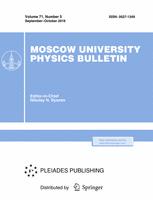In some crystals, polymers, and gels that contain hydrogen bonds OH…O, NH…O of length 2.8–3 Å or water molecules, gigantic anomaly of dielectric permittivity (ɛ ∼ 10$^3$–10$^6$) is observed in certain circumstances at frequencies of 1–10$^6$ Hz, which is accompanied by peculiarities in conductivity σ and dielectric losses tanδ. In crystals this effect appears after a sudden cooling to −50°C and it is observed at slow heating in the range of 20–40°C. At the return temperature course from 40°C dependences ɛ(T), σ(T), and tanδ(T) have their usual values. Anomalies in objects that differ by their compositions are unified by their temperatures, which are all close to 40°C. Authors have made an attempt to explain the similarity of these phenomena by the features of hydrogen bonds that are present in the objects.
77.70.+a Pyroelectric and electrocaloric effects
77.80.-e Ferroelectricity and antiferroelectricity
77.84.Fa KDP- and TGS-type crystals
Faculty of Physics, Moscow State University, Moscow, 119991, Russia



